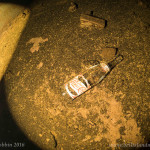It’s been a complicated mission to begin an archeological survey of the hundreds of miles of abandoned tunnels at Bell Island mine. This mine is so special because when the miners walked out in the mid 1960s, they thought they were going on a Christmas break. They left behind everything — lunch buckets, pipes, equipment, shoes — that they used in the mine. But the mine’s owners had other plans. They permanently closed the mine and turned off the pumps, so the freezing water rose, effectively preserving a snapshot of history. That’s what the divers are here to explore.
It’s hoped that the Bell Island mine can join well-known, similar destinations like Bonne Terre in Missouri, as a dive destination. Consequently, the divers are laying out mainlines to create a couple of permanent circuits for certified cave divers to explore the mine. Mine Quest is also conducting scientific experiments on decompression stress in conjunction with DAN — work that NASA is watching closely.
The Mine Quest divers began making forays into the abandoned tunnels at the beginning of last week, identifying and recording artifacts. They also laid more than 1,300 feet (400 m) of main line and conducted daily tests on the divers. All solid progress, but things haven’t been going so well on the surface. The expedition hit some rough waters outside the mine. As expedition co-leader Jill Heinerth observed, not unexpected, “I learned that you can do a lot of research and planning before an expedition,†she says. “Try and anticipate everything and the one thing that’s guaranteed is change…a lot of unexpected things are going to happen.â€
One storm after another has blown through the area. First, half the team was trapped on the island when the ferry shut down. The next day the whole team moved over to the island to avoid such delays, but before the move could be completed, the winds kicked up once again. The ferry shut down and half the expedition’s supplies were stuck on the mainland, including bottles of oxygen vital for the re-breathers. In an act of near desperation, Rick Stanley loaded the gear in his 24-foot RIB, put on a drysuit and headed across the bay with the supplies. “We’re adventurers, this is what feeds us,†he says. “We weren’t going to put our lives in jeopardy.†But his easy dismissal of his actions defies belief —remember, a 170-foot steel ferry had stopped running because of the high waves and winds.
As if that weren’t enough, the mine flooded the same day. The huge storms had dumped massive amounts of snow on the ground, and the next storm brought rain and warm temperatures. All the snow melted and started flowing downhill, into the mine. The water rose, effectively shutting down the staging area where the divers had worked all week, and volunteers came in to move thousands of pounds of equipment to a new area. The dive team had to rework all their plans and adjust their safety lines.
And as if to prove the old saying that bad things happen in threes, a third problem arose — this one more about comfort. There were no open hotels on Bell Island, so Stanley tracked down the owner of a bed & breakfast that operates in the summer and convinced them to open for the expedition. One minor problem — there are 11 beds and 20 people. Stanley took it all in his stride, saying “I love a challenge. I love to fix things. We’re on an island, so you know what, all these challenges are fantastic.â€
What’s Next at Bell Island Mine?
Despite the hiccups, the expedition’s work hasn’t slowed down for a moment. Divers are making discoveries on a daily basis, including massive carpets of bacterial colonies that live in absolute darkness, personal possessions left behind by the miners, huge pieces of mining equipment virtually intact and graffiti on the walls — personal messages left behind by miners who’ve long since passed away. Exploring the Bell Island Mine has been a sobering experience according to diver Jill Heinerth, “The mine feels a bit like a church,†she says. “I would want to whisper. I feel the presence of those souls who spent their lives and worked for their families there.â€
As for the scientific angle, Dr. Neal Pollock’s decompression experiments have led to new information about the effects of extreme diving in cold water on decompression stress. He’s been looking for a sure indicator of the onset of decompression sickness — that goal may be elusive, but he has made a new discovery about divers using electronic vests to stay warm on long, cold dives. Vests not only keep a diver warm, but also cause “better circulation, delivering inert gas into tissues,†he says. “If the garment fails and the diver gets cold as they surface, they can’t eliminate inert gas. That will increase decompression stress.â€
By the end of the week, everyone feels the expedition has been a resounding success. The divers think they’ve wedged open the door of a whole new world. “We have just scratched the surface,†says Heinerth. “We’ve explored a small piece of the mine. We have to come back and do some deeper and longer penetrations into some of the portions of the mine that were worked last.â€
And Rick Stanley thinks he’s started to build something very important for the province of Newfoundland. He hopes to have the mine open for certified divers in the summer of 2016.
The post Bell Island Mine Quest: Part IIIÂ Â Â Â Â Â Â Â Â Â Â Â appeared first on Scuba Diver Life.








